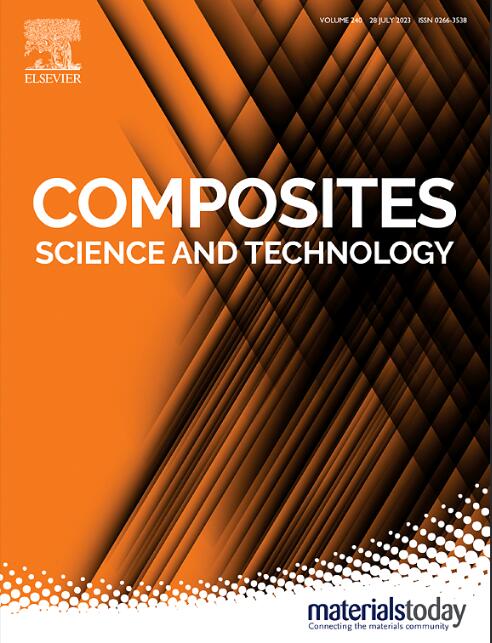Construction of hyperbranched polymer for advanced dental composites: Low shrinkage, high strength, and enhanced biocompatibility
IF 8.3
1区 材料科学
Q1 MATERIALS SCIENCE, COMPOSITES
引用次数: 0
Abstract
Dental restorative composites (DRCs) commonly result in secondary caries due to high polymerization shrinkage (PS) after curing and low strength property after long-term performance. To address this, a hyperbranched polymer (HBP) molecule named HTH, possessing rigid phenyl, cross-linkable methacrylate, and inter/intra molecular interactable urethane was synthesized via a one-step Michael addition and esterification process using 1,1,1-trimethylolpropane with N, N-di (2-hydroxyethyl)-3-aminopropyl meth-acrylate and then modified the hydroxyl terminals with 2-{[(3-isocyanato-4-methylphenyl) carbamoyl]oxy}ethyl 2-methylprop-2-enoate (TDI-HEMA). The obtained HTH molecule was characterized, and effect of the incorporation of HBP molecules utilized as one co-monomer was explored on the properties of DRCs prepared by fixed 25 wt% organic matrix constitute of bisphenol A-glycidyl methacrylate (Bis-GMA)/tri(ethylene glycol) dimethacrylate (TEGDMA) (weight ratio 50:50, referred to as 5B5T) and 75 wt% micro- and nano-hybrid silica (SiO2) fillers in details by Nuclear Magnetic Resonance spectroscopy (NMR), Fourier Transform Infrared Spectrometer (FT-IR), universal testing machine and density balance, etc. The measured results show: the HBP molecules, HTH, was synthesized successfully. The incorporation of HBP molecules reduces clearly the PS of DRCs, and the lowest PS of resultant DRCs could reach to 1.97 % by 20 wt% incorporation of HTH into 5B5T organic matrix and SiO2 particle systems meanwhile their mechanical properties remained robust (compressive strength at 355.7 MPa) and achieved excellent biocompatibility. This construction of new type of HBP molecules bearing functional moieties similar Bis-GMA characteristics as co-monomer offers a promising light to develop novel commercialized DRCs with high strength property and low PS, seamlessly blending durability and functionality.

用于高级牙科复合材料的超支化聚合物的构建:低收缩,高强度,增强生物相容性
牙科修复复合材料(DRCs)由于固化后的高聚合收缩率(PS)和长期使用后的低强度而导致继发性龋病。为了解决这一问题,以1,1,1-三甲基丙烷和N, N-二(2-羟乙基)-3-氨基丙基甲基丙烯酸酯为原料,通过一步迈克尔加成和酯化反应合成了一种含有刚性苯基、可交联甲基丙烯酸酯和分子间/分子内可相互作用的氨基丙烯酸酯的超支化聚合物(HTH)分子,然后用2-{(3-异氰酸酯-4-甲基苯基)氨基甲酰基氧}乙基2-甲基丙烯酸酯(TDI-HEMA)修饰了羟基末端。采用核磁共振(NMR)技术对所得的HTH分子进行了表征,并详细探讨了HBP分子作为共聚物的掺入对25 wt%由双酚a -甲基丙烯酸甘油酯(Bis-GMA)/三(乙二醇)二甲丙烯酸酯(TEGDMA)(重量比50:50,简称5B5T)和75 wt%微纳米杂化二氧化硅(SiO2)填料组成的固定有机基质制备的DRCs性能的影响。傅里叶变换红外光谱仪(FT-IR)、万能试验机、密度天平等。实验结果表明:成功合成了HBP分子HTH。在5B5T有机基质和SiO2颗粒体系中掺入20 wt%的HBP分子,所得DRCs的PS最低可达1.97%,同时其力学性能保持稳定(抗压强度为355.7 MPa),并具有良好的生物相容性。这种新型HBP分子的构建具有与双gma共聚单体相似的功能片段,为开发具有高强度性能和低PS,无缝融合耐用性和功能性的新型商业化DRCs提供了希望之光。
本文章由计算机程序翻译,如有差异,请以英文原文为准。
求助全文
约1分钟内获得全文
求助全文
来源期刊

Composites Science and Technology
工程技术-材料科学:复合
CiteScore
16.20
自引率
9.90%
发文量
611
审稿时长
33 days
期刊介绍:
Composites Science and Technology publishes refereed original articles on the fundamental and applied science of engineering composites. The focus of this journal is on polymeric matrix composites with reinforcements/fillers ranging from nano- to macro-scale. CSTE encourages manuscripts reporting unique, innovative contributions to the physics, chemistry, materials science and applied mechanics aspects of advanced composites.
Besides traditional fiber reinforced composites, novel composites with significant potential for engineering applications are encouraged.
 求助内容:
求助内容: 应助结果提醒方式:
应助结果提醒方式:


